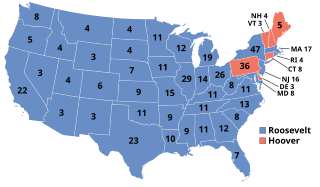
Presidential elections were held in the United States on November 8, 1932. Against the backdrop of the Great Depression, incumbent Republican President Herbert Hoover was defeated in a landslide by Democrat Franklin D. Roosevelt, the governor of New York and the vice presidential nominee of the 1920 presidential election. Roosevelt was the first Democrat in 80 years to simultaneously win an outright majority of the electoral college and popular vote, a feat last accomplished by Franklin Pierce in 1852, as well as the first Democrat in 56 years to win a majority of the popular vote, which was last achieved by Samuel J. Tilden in 1876. Roosevelt was the last sitting governor to be elected president until Bill Clinton in 1992. Hoover became the first incumbent president to lose an election to another term since William Howard Taft in 1912, the last to do so until Gerald Ford lost 44 years later, and the last elected incumbent president to do so until Jimmy Carter lost 48 years later. The election marked the effective end of the Fourth Party System, which had been dominated by Republicans. It was the first time since 1916 that a Democrat was elected president.

Wilbur Lucius Cross was an American literary critic who served as the 71st governor of Connecticut from 1931 to 1939.

The 1895 New Jersey gubernatorial election was held on November 5, 1895. Republican nominee John W. Griggs defeated Democratic nominee Alexander T. McGill with 52.28% of the vote.

The 1930 United States Senate election in Minnesota was held on Tuesday November 4, Incumbent Senator Thomas D. Schal defeated Einar Hoidale of the Minnesota Democratic Party and Forner United States Representative Ernest Lundeen of the Farmer–Labor Party of Minnesota to win a second term.

The 1936 United States Senate election in Oklahoma took place on November 3, 1936. Incumbent Democratic Senator Thomas Gore ran for re-election to his second consecutive term, and fifth term overall. He ended up easily losing renomination, however; he placed a distant fourth in the Democratic primary. A runoff election between Congressman Joshua B. Lee and Governor Ernest W. Marland resulted in a landslide win for Lee. In the general election, Lee faced Republican nominee Herbert K. Hyde, whom he overwhelmingly defeated.

The 1972 North Carolina gubernatorial election was held on November 7, 1972. Republican nominee James Holshouser defeated Democratic nominee Skipper Bowles with 51% of the vote. Holshouser thus became the first Republican elected governor of the state since 1896.

The 1938 Connecticut gubernatorial election was held on November 8, 1938. Republican nominee Raymond E. Baldwin defeated Democratic incumbent Wilbur Lucius Cross with 36.43% of the vote.

The 1936 Connecticut gubernatorial election was held on Tuesday November 3, to elect Governor of Connecticut Incumbent Governor Wilbur Lucius Cross defeated Republican nominee Arthur M. Brown with 55.29%, 372,953 votes.

The 1934 Connecticut gubernatorial election was held on November 6, 1934. Incumbent Democrat Wilbur Lucius Cross defeated Republican nominee Hugh Meade Alcorn with 46.71% of the vote.

The 1932 Connecticut gubernatorial election was held on November 8, 1932. Incumbent Democrat Wilbur Lucius Cross defeated Republican nominee John H. Trumbull with 48.44% of the vote.

The 1894 Connecticut gubernatorial election was held on November 6, 1894. Republican nominee Owen Vincent Coffin defeated Democratic nominee Ernest Cady with 54.18% of the vote. Coffin defeated Samuel E. Merwin in the Republican primary.

The 1905 Rhode Island gubernatorial election was held on November 7, 1905. Incumbent Republican George H. Utter defeated Democratic nominee Lucius F. C. Garvin with 53.30% of the vote.

The 1904 Rhode Island gubernatorial election was held on November 8, 1904. Republican nominee George H. Utter defeated Democratic incumbent Lucius F. C. Garvin with 48.94% of the vote.

The 1903 Rhode Island gubernatorial election was held on November 3, 1903. Incumbent Democrat Lucius F. C. Garvin defeated Republican nominee Samuel Pomeroy Colt with 49.29% of the vote.

The 1902 Rhode Island gubernatorial election was held on November 4, 1902. Democratic nominee Lucius F. C. Garvin defeated incumbent Republican Charles D. Kimball with 53.99% of the vote.

The 1901 Rhode Island gubernatorial election was held on November 5, 1901. Incumbent Republican William Gregory defeated Democratic nominee Lucius F. C. Garvin with 53.64% of the vote.

The 1932 Wisconsin gubernatorial election was held on November 8, 1932. Incumbent Republican Governor Philip La Follette was defeated in the Republican primary, and in the midst of the Great Depression and nationwide voter dissatisfaction with the Republican Party, Democratic nominee Albert G. Schmedeman defeated Republican nominee Walter J. Kohler Sr. and Socialist nominee Frank Metcalfe with 52.48% of the vote. Schmedeman became the first Democrat to win a gubernatorial election in Wisconsin since George Wilbur Peck in 1892. Two years later, in 1934, La Follette would run for governor again and defeated Schmedeman, this time running with the Progressive Party.

The 1890 Wisconsin gubernatorial election was held on November 4, 1890.

The 1900 Washington gubernatorial election was held on November 6, 1900.

The 1892 Wisconsin gubernatorial election was held on November 8, 1892. Incumbent Democratic Governor George Wilbur Peck narrowly defeated Republican nominee John Coit Spooner, becoming the first Democratic governor of Wisconsin to be reelected since Nelson Dewey in 1849.
























